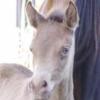Smokey brown & frosting
Forums
Re: Smokey brown & frosting
You're right. She'd have to be AAt.
I'm not sure either. I think alot of it is just that after the French study the people pretty much stop considering brown a separate entity and assumed it was just a darker version of bay. Now, because Dr. Michal hasn't published *yet* people don't want to believe it until he does. (Again I ask, do they trust the pearl test? UC Davis hasn't published that either.) I think it's simply a matter of not liking change.
I used to be VERY, VERY opposed to the theory of brown. At one point a true black and a very obvious brown moved into the field next to my horse where there was already a true bay and I got to look at all three of them every day and I started really seeing some major phenotypical differences that just seemed to go deeper than "just a dark shade of bay, like a liver chestnut" (but then again I really don't believe liver chestnut is just another shade of chestnut either). So I started paying attention to other horses and the more I looked, the more I learned and the more I learned I became more and more convinced of a genetic difference. That coupled with breeding results has put me on the bandwagon. But I haven't had as long a some people to get set in one train of thought.
Re: Smokey brown & frosting
[quote="accphotography"]You're right. She'd have to be AAt.
I'm not sure either. I think alot of it is just that after the French study the people pretty much stop considering brown a separate entity and assumed it was just a darker version of bay. Now, because Dr. Michal hasn't published *yet* people don't want to believe it until he does. (Again I ask, do they trust the pearl test? UC Davis hasn't published that either.) I think it's simply a matter of not liking change.
I used to be VERY, VERY opposed to the theory of brown. At one point a true black and a very obvious brown moved into the field next to my horse where there was already a true bay and I got to look at all three of them every day and I started really seeing some major phenotypical differences that just seemed to go deeper than "just a dark shade of bay, like a liver chestnut" (but then again I really don't believe liver chestnut is just another shade of chestnut either). So I started paying attention to other horses and the more I looked, the more I learned and the more I learned I became more and more convinced of a genetic difference. That coupled with breeding results has put me on the bandwagon. But I haven't had as long a some people to get set in one train of thought.[/quote]
I don't think its so much not liking brown as not sure if they can trust the research. Most people will trust UC Davis because of the reputation. Dr. Michal doesn't have the same extensive reputation to stand behind his work.




Re: Smokey brown & frosting
I thought I'd add my 2cents here about brown. I don't have any input into the seal vs brown exactly. Pet DNA is the only lab I am aware of that has even gotten this far and as far as I'm concerned, I would test any of mine with confidence but mostly because I have proof of my mares genetics by offspring as well as their testing. Macarena tests EE AA by the standard testing available at other labs that is currently offered. So, theoretically, all of those other labs are incorrect if you want to look at it that way. A brown horse is not bay. My true bay mare has had 3 brown foals out of 3 total foals. The first 2 foals looked bay at birth then shed the foal coat to reveal a silky, coal black coat with a tan muzzle. The latest foal also has a champagne gene but she could not be black (homozygous agouti) and does not look bay (amber champagne) so that leaves her as brown (sable champagne). I would test this filly when she's older if she sheds off with any question regarding bay or brown base color). This mare was bred to a black stallion the first 2 times and bay stallion this time and all of her foals are brown so she can only be a true AAt, correct? So, what is the argument regarding brown? I've seen a lot of much more brown "looking" horses that tested to be black with aa. There has to be a lot more that affects the visual appearance of these black based horses than simply whether they are black, bay or brown and this is no different than the obvious differences in the visual appearance of many red based horses and we don't know much about those either but that doesn't mean they aren't what they are, red. In my mares case, it's proven by her get and that is about all the real proof I need, the test is just confirming the obvious. I probably didn't catch everything in the previous posts so excuse me if I've missed something there.